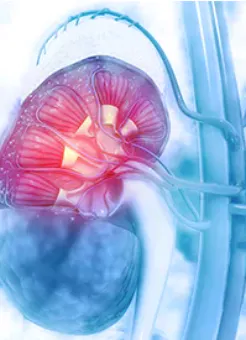Agnieszka Janus, MD, PhD, shares perspective on three cases of patients with HCL who were given vemurafenib after having progressed on multiple lines of treatment.
Agnieszka Janus, MD, PhD, Copernicus Memorial Hospital in Poland
Agnieszka Janus, MD, PhD
Vemurafenib (Zelboraf) is a safe and effective treatment option for heavily pretreated patients with hairy cell leukemia (HCL) who have progressed on moxetumomab pasudotox (Lumoxiti), according to Agnieszka Janus, MD, PhD.
It’s also a therapy that offers the opportunity to achieve durable responses and complete responses (CRs) when combined with rituximab (Rituxan), she added.
“It's very good that we have two drugs available in this space: moxetumomab pasudotox and vemurafenib,” said Janus, of Copernicus Memorial Hospital in Poland. “We can choose [which option] is more convenient for our patients. For those who are elderly, not very fit, or those who have active infections, I believe vemurafenib is the best treatment option.”
“From our experience, this is a drug that works even if we treated patients before with moxetumomab pasudotox, and it provides them with an opportunity to achieve CRs, even when we have exhausted all other treatment options,” Janus added.
Moxetumomab pasudotox, a CD22-directed recombinant immunotoxin, was approved by the FDA in September 2018 for the treatment of adult patients with HCL who have received ≥2 prior systemic therapies, including a purine nucleoside analog. Although a strong weapon to have in the treatment arsenal, patients will eventually relapse, said Janus. For those patients, the combination of vemurafenib plus rituximab may serve as a potential treatment strategy.
Moreover, prior results from a phase II, single-arm, single-center trial (EudraCT 2014-003046-27), which was led by Enrico Tiacci, MD, associate professor of hematology, University and Hospital of Perugia, Italy, showed that the combination of vemurafenib and rituximab was safe and non-myelotoxic, leading to deep and durable responses in patients with relapsed/refractory BRAF V600E—mutant HCL.
Of the 27 patients evaluable for efficacy, 26 patients achieved a CR (96%). At a median follow-up of 29.5 months, the progression-free survival (PFS) rate was 83% in 29 evaluable patients. Based on these results, investigators concluded that a randomized clinical trial comparing the combination with chemotherapy-based standard of care in the frontline setting is warranted. In an interview with OncLive during the 2019 Hairy Cell Leukemia Foundation Annual Conference, Janus shared perspective on three cases of patients with HCL who were given vemurafenib after having progressed on multiple lines of treatment.
OncLive: Could you discuss the efficacy and safety of moxetumomab pasudotox in HCL?
Janus: The efficacy of this agent is very great because it works even in patients who are heavily pretreated. For all of these patients, that means 5 or 6 lines of treatment. All of them respond in some [degree] to this antibody. Then, after a certain period of time, they relapse. However, it's a great drug—a new, non-chemotherapy drug. [The agent] is also safe; it doesn’t have many adverse events (AEs); less than 10% of serious AEs [have been reported], so we are very happy to have early access to the drug and to be able to [give it] to our patients.
What has been your experience with using vemurafenib in patients who become refractory to moxetumomab pasudotox?
HCL is a rare disease. Thus far, we have treated 4 patients who were relapsed/refractory after [moxetumomab pasudotox] therapy and all of them responded to vemurafenib. Some of them achieved, for the first time in their lives, CRs. As such, it's certainly a new quality [option] in the treatment of [patients with] HCL. Now, Italian investigators have proposed a clinical trial where they are evaluating vemurafenib as a first-line treatment in comparison with standard [chemotherapy], so the results they will obtain from that research will be very interesting.
Could you discuss the three patient cases that you highlighted in your presentation?
The most difficult [case that I shared was] of a 30-year-old patient. She started feeling bad in 2012; in 2013, she was diagnosed with HCL. She received upfront treatment with 2 courses of cladribine. After 1 course, she achieved just a partial remission (PR). We hoped that after she received the second course she would be doing better.
However, unfortunately, there was no improvement to that response. Eight months later, her disease was progressing. She received interferon[-α], but she didn't respond. Therefore, the third-line treatment was initiated, which was cetuximab (Erbitux) in combination with cladribine. She obtained just a PR, and 8 months later, her disease was progressing again.
It was 2015, and at that time we were lucky to have the phase I clinical trial with moxetumomab pasudotox, so she entered that trial. She received 6 cycles of treatment, and as result, she obtained hematologic remission. Another 8 months later, she progressed again; it was January 2016. We then started treatment with vemurafenib at 960 mg twice daily in combination with rituximab.
After 1 month, we had to reduce the dose of vemurafenib because she had many AEs. Once we reduced the dose to 240 mg, she was doing well. She finished treatment in April 2016, and for the first time in her life, she achieved a CR. In fact, for 2 years we [didn’t see] her because she was doing so well. She came back to us in January of this year, having relapsed again. We repeated the treatment with vemurafenib and rituximab and now we are awaiting the results. Thus far, she had a hematologic remission and she is doing well. This is the most difficult case. She doesn’t have any comorbidities, and she’s otherwise healthy; she just has HCL. There's a big question mark regarding what to do next with her.
The second case is a woman who was just 28 years old when she was diagnosed with classic HCL. For treatment, she received 1 course with cladribine, and she achieved a very good PR, which lasted 1.5 years before she relapsed. For second-line treatment, she received cladribine in combination with rituximab, but the response was even shorter; it lasted just 8 months. Then, she went on to receive interferon-α; it worked for 1 year. [At this point], she exhausted all of the standard treatment options and so she received another course of cladribine, which worked up until the year 2015. Again, this was the year when a clinical trial with moxetumomab pasudotox was available. She received 6 cycles of treatment and obtained a PR, but it was a very good quality PR. After the next 2 years, she was diagnosed with her next relapse. She received vemurafenib in combination with rituximab and obtained a CR with minimal residual disease (MRD) negativity. We were assessing response based on molecular tests. This patient finished treatment over 2 years ago and she is still doing very well. She's in CR; it's the longest remission in her life so far.
The third patient is a more standard case; he was 67 years old when he was diagnosed with HCL. He received many courses of treatment with cladribine. He was diagnosed in 1994; we didn't have many drugs available at that time. As such, he received, in total, 5 courses of cladribine in 2-year intervals. He always obtained just PR.
In 2015, he entered clinical trial, again with moxetumomab pasudotox, and he obtained a very good response; it was an MRD-negative CR that lasted for 3 years. However, he was admitted to the hematology department in August 2019 because of progressive pancytopenia. We performed all of the laboratory tests to confirm the relapse. Unfortunately, he experienced septic shock in the first week of hospitalization while we awaited results from the tests. He improved, but unfortunately, the next one occurred 2 weeks later. We initiated vemurafenib but it didn't even have a chance to start working because unfortunately, he died of multiorgan failure at the end of September 2019.
Could you expand on what the safety profile looks like with vemurafenib?
The most common AEs that the patients experience are arthritis, arthralgia, photosensitivity, and skin rash. However, all of those events [are manageable] when we reduce the dose of the drug or when we add some steroids to the treatment. We didn't observe any severe AEs [with the agent]. We didn't have any situations where we had to interrupt the treatment due to AEs either, so it's safe and causes quite rapid morphology recovery. We believe that [after] the first 3 or 4 weeks [of treatment], we are able to [improve] the morphology [of the disease], which makes this treatment safe in patients who are at risk of severe infections.
Tiacci E, Carolis LD, Simonetti E, et al. The BRAF inhibitor vemurafenib combined with rituximab produces a high rate of deep and durable remissions in relapsed or refractory hairy cell leukemia: updated results of a phase-2 trial. Presented at: 2019 European Hematology Association Congress; June 13-16, 2019; Amsterdam, The Netherlands. Abstract S104. http://bit.ly/2JlxuGL.
<<< View more from the 2019 Hairy Cell Leukemia Foundation Annual Conference








Post comments